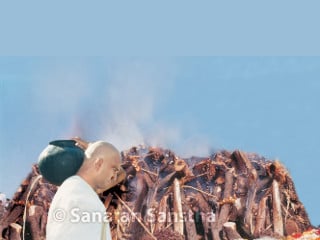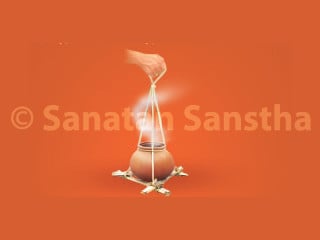To enable mankind to get closer to God through the medium of various events that occur from birth to death, Hindu Dharma has formulated various religious sanskārs. Among them, the post-death rite is the final sanskār. If post-death rites are performed with faith and as prescribed by our Scriptures, then the linga-dēha (subtle body) of the deceased person, without getting trapped in Bhulok (Earth region) or Martyalok (The region of the dead), acquires a positive momentum and moves on to higher regions. Consequently, the possibility of the deceased person tormenting the family members reduces.
After the death of a person, many a time it is seen that the funeral rite is performed merely as a formality or as a part of fulfilling duty towards the family. If post-death rites are performed as prescribed by our Scriptures, then the linga-dēha (subtle-body) of the deceased person, without getting trapped in Bhulok (Earth region) or Martyalok (In the region of the dead), acquires a positive momentum and moves on to higher regions. Consequently, the possibility of the deceased person (Ancestor) tormenting the family members reduces.
After the death of a person, many a time it is seen that the funeral rite is performed merely as a formality or as a part of fulfilling duty towards the family. If post-death rites are performed as prescribed by our Scriptures, then the linga-dēha (subtle-body) of the deceased person, without getting trapped in Bhulok (Earth region) or Martyalok (In the region of the dead), acquires a positive momentum and moves on to higher regions. Consequently, the possibility of the deceased person (Ancestor) tormenting the family members reduces.
Once a person dies, his/her post-death rites are to be performed at the hands of a priest as mentioned in the Scriptures. Finding a priest with the knowledge of post-death rites is difficult in most places. Under such circumstances, one should place the dead body on the pyre in such a manner that the feet of the dead body are towards the north. The reasons and science underlying such an act are explained in the article.
Rituals after death : Often, when the prān (vital energy) leaves the gross body, the mouth remains open, and through this open mouth, putrefying waves from the dead body spread into the environment. By pouring Gangājal and placing tulsī (basil) leaves in the mouth, Sattva waves from the Universe get attracted to these sāttvik objects placed in the mouth. This brings about disintegration of putrefying waves released from the mouth into environment, thus keeping the environment pure.
After the death of a person, many a times it is seen that, the funeral rite is performed merely as a formality set by the Scriptures or as a part of fulfilling duty towards the family. Most people do not know its importance or the underlying spiritual science. When a person understands the precise science underlying an act, his faith in the act increases, he realises its importance and this induces him to perform the act with enhanced faith.
If post-death rites are performed with faith and as prescribed by our Scriptures, then the linga-dēha (subtle body) of the deceased person, without getting trapped in Bhulok (Earth region) or Martyalok (In the region of the dead), acquires a positive momentum and moves on to higher regions. Consequently, the possibility of the deceased person tormenting the family members reduces. The possibility of such a linga-dēha being enslaved by negative energies reduces too.
A person who does not perform sādhanā (Spritual practice) of chanting the Name of God remains entrapped in one species of living beings for years together or becomes a slave to negative energies; whereas, a person who chants the Name of God at the time of death attains subsequent momentum.
The 108 frequencies that reach the earth are of three types namely creation, sustenance and dissolution. Conjoint frequencies are also included in the 108 frequencies. Since these conjoint frequencies contain the three frequencies, the cycles of birth and death continue.




